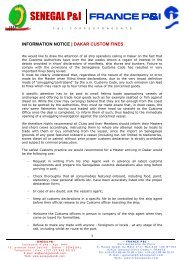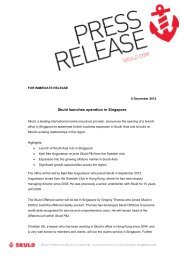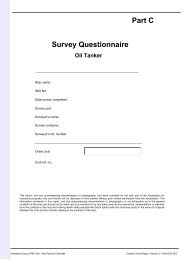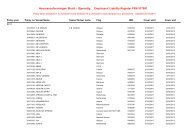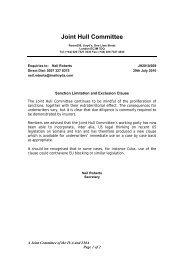Create successful ePaper yourself
Turn your PDF publications into a flip-book with our unique Google optimized e-Paper software.
Suit<br />
For the purposes of English law, suit is<br />
commenced as follows:<br />
High Court:<br />
Issuing of Claim Form<br />
County Court:<br />
Issuing of Claim Form<br />
Arbitration – 2/3 man:<br />
Appointment of an Arbitrator, notice of<br />
the appointment being given to the<br />
respondent and calling upon them to<br />
appoint their Arbitrator.<br />
Sole Arbitrator/LMAA Small Claims:<br />
Calling upon the respondent to agree<br />
a sole Arbitrator.<br />
Who is protected by the time bar?<br />
There has been significant discussion as<br />
to who can claim the protection offered<br />
by the time bar. We do not have time to<br />
consider this in any detail, suffice it to<br />
say that the ship and its owner will be<br />
protected in relation to cargo claims<br />
brought under bills of lading and those<br />
brought under charterparties that<br />
incorporate a Clause Paramount. While<br />
the charterer as the carrier under a bill<br />
of lading will also be able to rely on the<br />
time bar, the charterer cannot rely on it<br />
when facing an owner claiming against<br />
them in relation to cargo, even if the<br />
charterers are the carrier under the<br />
relevant bill of lading.<br />
It’s all in the delivery – when, where and to whom<br />
What starts the clock<br />
It is important for all parties to know<br />
from what date the 12-month period<br />
runs. At first glance, the rules answer<br />
that question – it is the date of delivery<br />
or the date on which the goods should<br />
have been delivered. However, it is not<br />
always as simple as it sounds; not least<br />
because of the reliance placed on the<br />
clause regarding the question of delivery.<br />
Delivery -v- discharge<br />
There seems to be no consensus on what<br />
constitutes delivery, save that it is an<br />
entirely different concept than that of<br />
discharge. Discharge is a purely physical<br />
act. Delivery is a legal concept. Despite<br />
its importance to the rules, neither the<br />
Hague nor the Hague-Visby Rules define<br />
it. According to Carver on bills of lading,<br />
delivery is "ordinarily taken to refer to the<br />
transfer of possession to a consignee, or<br />
to the consignee’s agent". Voyage<br />
Charters by Cooke et al. also links<br />
delivery to the passing of actual or<br />
constructive possession. Given the<br />
importance placed on the passing of<br />
possession, it is, therefore, implicit that<br />
the goods have been discharged into the<br />
possession of the person entitled to the<br />
goods (so, for example, delivery will<br />
usually be taken as delivered if the cargo<br />
was discharged against presentation of<br />
an original bill of lading). Where there is<br />
misdelivery, there will be no delivery for<br />
the purposes of Article III, rule 6.<br />
Place of delivery<br />
The usual scenario is for cargo to have<br />
been shipped from A to B. Complications<br />
can arise where, for example, the owner<br />
carries cargo from A to B, but following<br />
rejection of the cargo by the receivers, it is<br />
then carried to C where it is finally<br />
delivered. Whilst cargo was eventually<br />
delivered at C, it should have been<br />
delivered at B sometime earlier. This is<br />
particularly a problem where a cargo<br />
claim is brought under a charterparty as<br />
opposed to a bill of lading. In this<br />
situation, the 12-month period could<br />
either run from the date the cargo should<br />
have been delivered at B or the date when<br />
the cargo was actually delivered at C.<br />
This was the dilemma faced by the owners<br />
and charterers of the Sonia. Charterers<br />
alleged cargo was damaged whilst on<br />
board the ship en route from A to B and,<br />
following its rejection at B, charterers sold<br />
the cargo at a lower price for delivery at C.<br />
Charterers paid additional freight to the<br />
owners to carry the cargo and deliver it at<br />
C. They then sought to claim their losses<br />
from owners. They commenced<br />
proceedings within 12 months of delivery at<br />
C, but outside the 12–month period if it<br />
were calculated from the date when the<br />
cargo should have been delivered at B.<br />
Owners sought summary judgment that<br />
charterers’ claim was time barred and the<br />
High Court Judge agreed with owners’<br />
case. He held that the one-year period ran<br />
from the date the goods should have been<br />
delivered at B.<br />
BEACON 25


